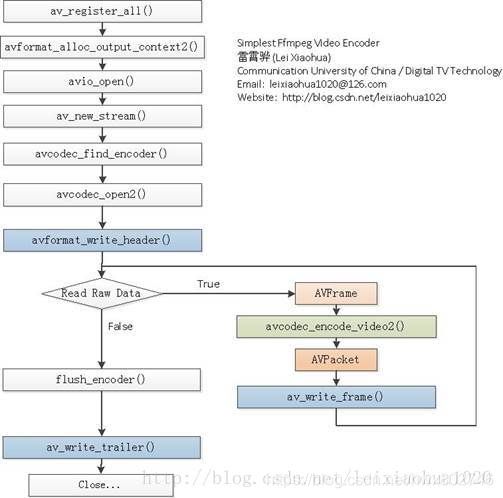代码不用说,源于雷神!最简单的基于FFMPEG的视频编码器(YUV编码为H.264)
注意:本文只多加了注释 且 注释的非常详细,方便我等小白学习。
【几乎每行都有必要注释】
第一次研究ffmpeg编解码,甚是艰难,但好在有些进展,将看起来费劲的部分都进行注释了一把,分享一下。
建议方式:先熟悉视频编码流程,再看代码就轻松了。

/**
*************** FFMPEG视频编码流程 *******************
* 01、av_register_all():注册FFmpeg所有编解码器;
* 02、avformat_alloc_output_context2():初始化输出码流的AVFormatContext;
* 03、avio_open():打开输出文件;
* 04、av_new_stream():创建输出码流的AVStream;
* 05、avcodec_find_encoder():查找编码器;
* 06、avcodec_open2():打开编码器;
* 07、avformat_write_header():写文件头(对于某些没有文件头的封装格式,不需要此函数。比如说MPEG2TS);
* 08、不停地从码流中提取出YUV数据,进行编码;
* avcodec_encode_video2():编码一帧视频。即将AVFrame(存储YUV像素数据)编码为AVPacket(存储H.264等格式的码流数据);
* av_write_frame():将编码后的视频码流写入文件;
* 09、flush_encoder():输入的像素数据读取完成后调用此函数。用于输出编码器中剩余的AVPacket;
* 10、av_write_trailer():写文件尾(对于某些没有文件头的封装格式,不需要此函数。比如说MPEG2TS);
*/
#include <stdio.h>
#define __STDC_CONSTANT_MACROS
#ifdef _WIN32
//Windows
extern "C"
{
#include "libavutil/opt.h"
#include "libavcodec/avcodec.h"
#include "libavformat/avformat.h"
};
#else
//Linux...
#ifdef __cplusplus
extern "C"
{
#endif
#include <libavutil/opt.h>
#include <libavcodec/avcodec.h>
#include <libavformat/avformat.h>
#ifdef __cplusplus
};
#endif
#endif
// 输入的像素数据读取完成后调用此函数,用于输出编码器中剩余的AVPacket
int flush_encoder(AVFormatContext *fmt_ctx,unsigned int stream_index){
int ret;
int got_frame;
AVPacket enc_pkt;
if (!(fmt_ctx->streams[stream_index]->codec->codec->capabilities & CODEC_CAP_DELAY))
return 0;
while (1) {
enc_pkt.data = NULL;
enc_pkt.size = 0;
av_init_packet(&enc_pkt);
//编码一帧视频。即将AVFrame(存储YUV像素数据)编码为AVPacket(存储H.264等格式的码流数据)。
ret = avcodec_encode_video2 (fmt_ctx->streams[stream_index]->codec, &enc_pkt,
NULL, &got_frame);
av_frame_free(NULL);
if (ret < 0)
break;
if (!got_frame){
ret=0;
break;
}
printf("Flush Encoder: Succeed to encode 1 frame!\tsize:%5d\n",enc_pkt.size);
/* mux encoded frame */
ret = av_write_frame(fmt_ctx, &enc_pkt);
if (ret < 0)
break;
}
return ret;
}
int main(int argc, char* argv[])
{
AVFormatContext* pFormatCtx; // 封装格式上下文结构体,也是统领全局的结构体,保存了视频文件封装 格式相关信息。
AVOutputFormat* fmt; // AVOutputFormat 结构体主要用于muxer,是音视频文件的一个封装器。
AVStream* video_st; // AVStream是存储每一个视频/音频流信息的结构体。
AVCodecContext* pCodecCtx; // 编码器上下文结构体,保存了视频(音频)编解码相关信息。
AVCodec* pCodec; // AVCodec是存储编解码器信息的结构体。
AVPacket pkt; // AVPacket是存储压缩编码数据相关信息的结构体
uint8_t* picture_buf;
AVFrame* pFrame; // AVFrame是包含码流参数较多的结构体
int picture_size;
int y_size;
int framecnt=0;
//FILE *in_file = fopen("src01_480x272.yuv", "rb"); // 输入原始YUV数据
FILE *in_file = fopen("../ds_480x272.yuv", "rb"); // 输入原始YUV数据
int in_w=480,in_h=272; // 输入数据的宽度和高度
int framenum=100; // 要编码的帧
//const char* out_file = "src01.h264"; // 输出文件路径
//const char* out_file = "src01.ts";
//const char* out_file = "src01.hevc";
const char* out_file = "ds.h264";
av_register_all(); // 注册ffmpeg所有编解码器
//方法1.
pFormatCtx = avformat_alloc_context(); // 初始化 pFormatCtx。 AVFormatContext 用 avformat_alloc_context() 进行初始化
//Guess Format
fmt = av_guess_format(NULL, out_file, NULL); // av_guess_format 这是一个决定视频输出时封装方式的函数,其中有三个参数,写任何一个参数,都会自动匹配相应的封装方式。
pFormatCtx->oformat = fmt;
//方法2.
//avformat_alloc_output_context2(&pFormatCtx, NULL, NULL, out_file); // 初始化输出码流的AVFormatContext
//fmt = pFormatCtx->oformat;
//Open output URL
if (avio_open(&pFormatCtx->pb,out_file, AVIO_FLAG_READ_WRITE) < 0){
// avio_open 打开输出文件
printf("Failed to open output file! \n");
return -1;
}
video_st = avformat_new_stream(pFormatCtx, 0); // 创建输出码流的AVStream
video_st->time_base.num = 1; // num 分子
video_st->time_base.den = 25; // den 分母
if (video_st==NULL){
return -1;
}
// 必须设置的参数
pCodecCtx = video_st->codec;
//pCodecCtx->codec_id =AV_CODEC_ID_HEVC;
pCodecCtx->codec_id = fmt->video_codec;
pCodecCtx->codec_type = AVMEDIA_TYPE_VIDEO;
pCodecCtx->pix_fmt = PIX_FMT_YUV420P;
pCodecCtx->width = in_w;
pCodecCtx->height = in_h;
pCodecCtx->time_base.num = 1;
pCodecCtx->time_base.den = 25;
pCodecCtx->bit_rate = 400000;
pCodecCtx->gop_size=250;
//H264
//pCodecCtx->me_range = 16;
//pCodecCtx->max_qdiff = 4;
//pCodecCtx->qcompress = 0.6;
pCodecCtx->qmin = 10;
pCodecCtx->qmax = 51;
// 可选参数
pCodecCtx->max_b_frames=3;
// 设置选项
AVDictionary *param = 0;
//H.264
if(pCodecCtx->codec_id == AV_CODEC_ID_H264) {
av_dict_set(¶m, "preset", "slow", 0);
av_dict_set(¶m, "tune", "zerolatency", 0);
//av_dict_set(¶m, "profile", "main", 0);
}
//H.265
if(pCodecCtx->codec_id == AV_CODEC_ID_H265){
av_dict_set(¶m, "preset", "ultrafast", 0);
av_dict_set(¶m, "tune", "zero-latency", 0);
}
//Show some Information
av_dump_format(pFormatCtx, 0, out_file, 1); // av_dump_format()是一个手工调试的函数,能使我们看到pFormatCtx->streams里面有什么内容。
pCodec = avcodec_find_encoder(pCodecCtx->codec_id); // 查找编码器
if (!pCodec){
printf("Can not find encoder! \n");
return -1;
}
if (avcodec_open2(pCodecCtx, pCodec,¶m) < 0){
// 打开编码器
printf("Failed to open encoder! \n");
return -1;
}
pFrame = av_frame_alloc(); // AVFrame结构,av_frame_alloc申请内存,av_frame_free释放内存
picture_size = avpicture_get_size(pCodecCtx->pix_fmt, pCodecCtx->width, pCodecCtx->height); //计算这个格式的图片,需要多少字节来存储
picture_buf = (uint8_t *)av_malloc(picture_size);
// 这个函数是为已经分配的空间的结构体AVPicture挂上一段用于保存数据的空间
avpicture_fill((AVPicture *)pFrame, picture_buf, pCodecCtx->pix_fmt, pCodecCtx->width, pCodecCtx->height);
// 写文件头(对于某些没有文件头的封装格式,不需要此函数。比如说MPEG2TS)。
avformat_write_header(pFormatCtx,NULL);
av_new_packet(&pkt,picture_size); // 分配数据包的有效size并初始化
y_size = pCodecCtx->width * pCodecCtx->height;
// 一帧一帧循环操作
for (int i=0; i<framenum; i++){
// Read raw YUV data
if (fread(picture_buf, 1, y_size*3/2, in_file) <= 0){
// fread函数,从文件流中读取数据,如果不成功或读到文件末尾返回 0
printf("Failed to read raw data! \n");
return -1;
}else if(feof(in_file)){
// 判断文件是否结束
break;
}
pFrame->data[0] = picture_buf; // Y
pFrame->data[1] = picture_buf+ y_size; // U
pFrame->data[2] = picture_buf+ y_size*5/4; // V
// PTS
pFrame->pts=i; // pts : 以时间为基本单位的表示时间戳(应该向用户显示帧的时间)。
int got_picture=0;
// 编码一帧视频。即将AVFrame(存储YUV像素数据)编码为AVPacket(存储H.264等格式的码流数据)。
// 成功时返回0,失败时返回负错误代码 失败时返回错误返回码
int ret = avcodec_encode_video2(pCodecCtx, &pkt,pFrame, &got_picture);
if(ret < 0){
printf("Failed to encode! \n");
return -1;
}
if (got_picture==1){
printf("Succeed to encode frame: %5d\tsize:%5d\n",framecnt,pkt.size);
framecnt++;
pkt.stream_index = video_st->index;
ret = av_write_frame(pFormatCtx, &pkt); // 将编码后的视频码流写入文件,
av_free_packet(&pkt); // free
}
}
// Flush Encoder
int ret = flush_encoder(pFormatCtx,0); // 输入的像素数据读取完成后调用此函数,用于输出编码器中剩余的AVPacket
if (ret < 0) {
printf("Flushing encoder failed\n");
return -1;
}
// 写文件尾(对于某些没有文件头的封装格式,不需要此函数。比如说MPEG2TS)
av_write_trailer(pFormatCtx);
// Clean
if (video_st){
avcodec_close(video_st->codec);
av_free(pFrame);
av_free(picture_buf);
}
avio_close(pFormatCtx->pb);
avformat_free_context(pFormatCtx);
fclose(in_file);
return 0;
}
再次致敬雷神!
结束:
分享也是自己对问题再次加深理解的方式,可能不全面,但绝对有用,后面将不断完善~